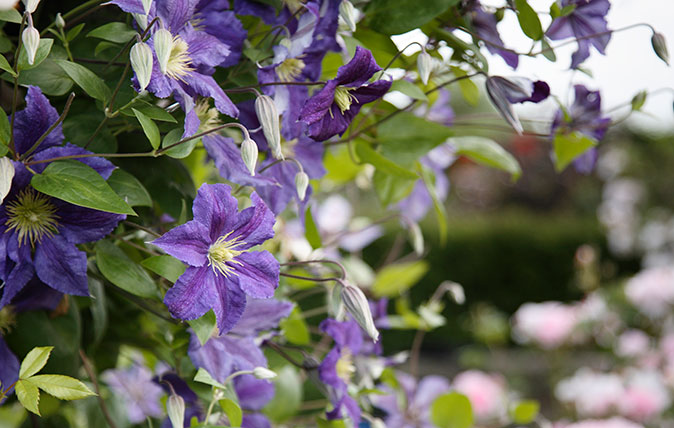How to choose the perfect Clematis – and how to help it flourish
Steven Desmond gives his tips on how to look after clematis, the beautiful climbing plant whose flowers explode in spring.


There are more than 300 species of Clematis and rather a lot of them make good garden plants. The colour range of the flowers isn’t great – chiefly whites, reds, blues and combinations thereof – but nature and breeders between them have been able to generate all sorts of delightful combinations of form, size, texture and habit, so that the main problem with the genus is the sheer number of cultivars in any catalogue. Then there’s the famous minefield of pruning regimes. Perhaps some simplification would help.
Let’s start with the pleasures of spring. It happens that a relatively small range of Clematis species flowers in a British spring and that all of them are easy to grow. The most familiar of these is surely C. montana. I read one description recently that suggested it has a delicate constitution. I could hardly believe my eyes.
C. Montana is vigorous, hardy, adaptable, pretty and wonderfully scented. It’s the ideal cover for an unsightly shed and should be planted nowhere near the door if you wish to get in and out.
Its four tepals, as if made of stiff paper, come in a narrow range of shades from off-white (in Elizabeth) to pale pink (in Rubens). Its cheerful disposition has always appealed to me, as has its great willingness to grow on a shady wall.
Another favourite of mine is C. macropetala. Despite the name, the petals are small: none of these spring forms has the giant stars of the summer parade. The flowers of C. macropetala hang gracefully like little handkerchiefs and are a lovely powderblue against the fresh green of the new leaves. All this gives the whole plant a freshness and delicacy entirely in tune with the spring flora around it. The display only lasts a week or so, but it makes me happy when I walk by.
It ought to be impossible to improve on such divine beauty, but there are other colour selections that make me wonder. The flowers of C. macropetala Markham’s Pink, named after William Robinson’s head gardener, make a fine alternative, although I wouldn’t like to see the two side by side. White Columbine is a good white form with longer, elegantly fingery tepals. All these colour forms look winningly pretty hovering over a ground cover of violets and primroses.
This latter is sometimes listed under cultivars of C. alpina and we need not doubt the hybrid nature of such creations. That species is another source of early charmers. Frances Rivis, another long-standing favourite, is an excellent form, with richly violet hanging tepals. Tage Lundell is a more recent alternative, its pendent flowers opening lilac and darkening to plum-red as they age. All the above are easily grown in spaces of modest size, as they are not vigorous.
Exquisite houses, the beauty of Nature, and how to get the most from your life, straight to your inbox.

For my money, however, the prince of spring flowerers is C. armandii, introduced to Edwardian society by ‘Chinese’ Wilson and named after Armand David, the Catholic missionary who pointed the way to so many choice finds. C. armandii is a rapid grower and will quite happily climb to the top of any tree you show it to. This is not a good move, however, as you’ll need binoculars to see the flowers. It’s better to think of all Clematis as hedgerow scramblers.
The flowers of C. armandii are off-white and there are good pink-tinged forms, such as the predictably named Apple Blossom. It’s the foliage, however, that makes this plant such good value: thick, dark, handsome evergreen leaves in elegant groups of three. They remind me of another foliage staple in the garden, Viburnum davidii, named after the same excellent fellow.
I’ve left the delicate subject of pruning until last. This is a question that sits like a dark cloud on the countenance of every clematis fancier, as it appears such an arcane subject.
Be of good cheer, therefore, with the spring flowerers, as they need no pruning at all, beyond a bit of tidying up, best done straight after flowering. You’ll need to prevent C. montana climbing into your loft and cutting out lengths of C. macropetala involves following errant shoots to their base to avoid removing the wrong bit, but there’s no mystery to solve here. Enjoy!
Steven Desmond
Country Life is unlike any other magazine: the only glossy weekly on the newsstand and the only magazine that has been guest-edited by His Majesty The King not once, but twice. It is a celebration of modern rural life and all its diverse joys and pleasures — that was first published in Queen Victoria's Diamond Jubilee year. Our eclectic mixture of witty and informative content — from the most up-to-date property news and commentary and a coveted glimpse inside some of the UK's best houses and gardens, to gardening, the arts and interior design, written by experts in their field — still cannot be found in print or online, anywhere else.
